Bradbury Science Museum – Los Alamos
Tuesday, May 15, 2007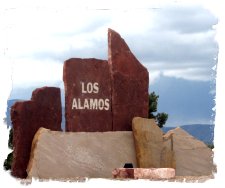 The last thing we expected to see at the Bradbury Science Museum at Los Alamos was a group of Japanese students. But there they were, in a museum devoted to chronicling the Manhattan Project and the development of the atomic bombs. Vance and I trailed behind the group for a little while, fascinated by the interaction of the tour guide and interpreter with the students.
The last thing we expected to see at the Bradbury Science Museum at Los Alamos was a group of Japanese students. But there they were, in a museum devoted to chronicling the Manhattan Project and the development of the atomic bombs. Vance and I trailed behind the group for a little while, fascinated by the interaction of the tour guide and interpreter with the students.Not only is the museum about the atomic bombs, it is also a showcase for the Los Alamos National Laboratories. It’s a wonderful museum (and free!). A large portion of the museum is devoted to the history of WWII, the Manhattan Project (particularly Los Alamos), and the development, tests and usage of the 2 atomic bombs in Hiroshima and Nagasaki. The other sections focused on the ongoing activities of the lab, including nuclear testing and handling of highly radioactive materials.
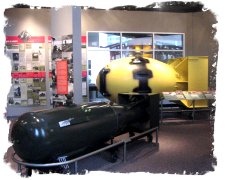 Vance has developed a fascination with the story of the Fat Man and Little Boy atomic bombs – he first learned of them when we went to the FDR Presidential Library in Hyde Park last fall. I think his interest may be in part driven simply by the names, but he’s got a reasonable grasp on which one used uranium vs. plutonium, and why.
Vance has developed a fascination with the story of the Fat Man and Little Boy atomic bombs – he first learned of them when we went to the FDR Presidential Library in Hyde Park last fall. I think his interest may be in part driven simply by the names, but he’s got a reasonable grasp on which one used uranium vs. plutonium, and why.We live close to Lake Fontana, constructed during WWII solely to provide electrical power to the uranium enrichment facilities at Oak Ridge, TN. Vance understands that the uranium used in the Little Boy bomb was created using Fontana Dam electricity. The museum had full sized mockups of both bombs, which he took quite an interest in.
Due to the ban on nuclear testing signed by President Bush, the labs now operate under what is called ‘Rebound’. Unable to test nuclear devices by setting them off and observing the results, the labs now focus on testing the many components of the weapons in what they call ‘sub-critical’ testing. Much focus was given on the difficulties of maintaining and testing the nuclear arsenal, and materials age and must be replaced.
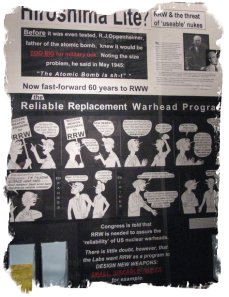 There is some criticism of the labs that they are simply focused on protecting the lab’s existence (and jobs) with this effort, and that it doesn’t really matter all that much if the explosions can be calculated and modeled to the nth degree, as long as they work if needed (god forbid). But of course the lab thinks otherwise, and a whole section of the museum is devoted to the topic of how they test and model the weapon, and the creativity involved. There was one very interesting display showing how underground tests used to be performed, and how some of the instrumentation for capturing test results worked. For a geek like me, it was extremely interesting.
There is some criticism of the labs that they are simply focused on protecting the lab’s existence (and jobs) with this effort, and that it doesn’t really matter all that much if the explosions can be calculated and modeled to the nth degree, as long as they work if needed (god forbid). But of course the lab thinks otherwise, and a whole section of the museum is devoted to the topic of how they test and model the weapon, and the creativity involved. There was one very interesting display showing how underground tests used to be performed, and how some of the instrumentation for capturing test results worked. For a geek like me, it was extremely interesting.Of course, there are always spinoffs . The lab has a huge amount of expertise in large scale computer modeling (and have massive computers), and have applied this expertise in other areas, such as modeling pandemics and how to react to them to minimize overall impact, traffic modeling, and creating radioactive isotopes, such as those used for medical imaging, cancer treatments, etc…..
We’ve been listening to a series of lectures called ‘Physics for Future Presidents’. This is an introductory Physics class taught at UC Berkeley that I’ve downloaded from the internet. Why, you might ask, are we listening to a college lecture series when Vance is in 5th grade? The reason is that the lectures are aimed at providing a real world basis for physics for people who will never become physicists – people like Denise and I. They are fascinating – despite having an Electrical Engineering degree, which basically is applied physics with a lot of screwy math, I’ve learned tons of stuff about how the world works. Denise has also enjoyed the lectures, and they are so well done that it has been my belief that Vance would walk away with some level of understanding. We usually listen to them when we will be in the car for several hours, to help break up the trip
Today we put that theory to the test. The museum had a kiosk with a quiz on radiation. In some ways, they were trick questions, in that the correct answer was not the necessarily the one that conventional wisdom may have you pick out. Before listening to these lectures, I would have scored about 50% correct, at best.
I had Vance take the quiz. As much as he moans and groans about having to listen to the lectures, today proved me right – he scored 80% . This settled any question in mine and Denise's minds on the value of the lectures, and other similar forms of education (CDs with songs of vocabulary words, etc….) Vance tends to pick up a lot of information when we don’t really think he’s paying attention, and I try to play off of that. I also try to tie in what we’ve heard in the lectures when it correlates to something we see somewhere…”hey, remember how the guy in the physics lecture was talking about how much fuel it took to put something in space? Look at how much thrust it took to get an Apollo rocket off the ground…..”
We had recently listened to several lectures on nuclear energy, learning about the various types of radiation given off by nuclear reactions. The museum had a really neat exhibit where 3 different elements decayed to give off radioactive Alpha, Beta and Gamma particles. According to what we had learned, and what the museum display confirmed, Alpha particles won’t pass through clothing or skin. With a Geiger counter, we were able to test this out. Beta particles won’t travel far through air, and again we confirmed it. However, Gamma rays will pass through most anything (except lead), and this is the reason shielding is required for X-rays.. Using a variety of shields (wood, glass and lead), we were able to see the difference for ourselves how pervasive Gamma rays are.
A very interesting display demonstrated the amount of radioactivity in common items, such as watch dials that glow in the dark and mantles for Coleman lanterns. A set of brightly colored plates (Fiestaware) manufactured in the 30’s using material with traces of uranium in it really set off the Geiger counter!
Weren’t we a little scared being around all that radioactivity? Well, this is where we really learned a lot on the lectures and at the museum. Radioactivity is dangerous in large amounts, but what most people (ourselves included) don’t realize is it takes a lot of radiation to potentially harm someone, and that we are constantly receiving radiation from the natural environment around us. In fact, there is natural radiation in the human body, and common elements like granite are ‘hot’. There is a significant difference in the amount of natural radiation you receive depending on the altitude of where you live, or the soil content. We’re surrounded by the stuff.
Take a few minutes and work through the chart below to determine how much radioactivity you typically receive in a year. It may seem like a lot (measured in milliREMS, or 1/1000th of a REM), until you understand that it takes nearly 2000 REMS to receive an absolutely fatal dose of radiation. Anything under that simply makes it a small statistical change in your change of getting cancer from it.
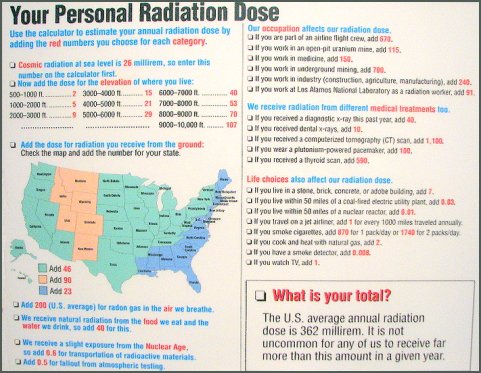
How small? Increasing a typical American’s dosage by a full REM annually (usually about quadrupling a typical dose) would statistically increase the risk of cancer by 0.1% (or by 1/1000th). 17% of Americans ultimately die of cancer, so even getting a pretty stiff dose of radiation repeatedly over your lifetime makes a minuscule change in your odds of getting cancer – 17.1%, vs 17%.
I’ve often wondered how people worked around radiation, particularly in cleanup situations. Now I know – unless you breathe a radioactive particle in, or ingest something through a cut, it really won’t hurt you unless it’s very, very radioactive and giving off lots of gamma particles.
Speaking of ingesting, take a look at the chart above again, and other than a CT Scan, find what is the highest factor for exposure to radioactivity. The result might surprise you:
Cigarettes:
- 800 milliREMS for a 1 pack a day
- 1.740 REMS (1740 milliREMS) for 2 packs a day
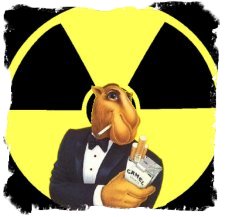 Although not scientifically proven, there are many in the medical field that believe that the radiation contained in the particles inhaled by smokers entirely accounts for the increase risk of lung cancer in smokers. The impact is worsened by the fact the radioactive particles are typically captured in the lung due to the tar in cigarettes, where the radiation gets to work its evil ways year after year after year at short range.
Although not scientifically proven, there are many in the medical field that believe that the radiation contained in the particles inhaled by smokers entirely accounts for the increase risk of lung cancer in smokers. The impact is worsened by the fact the radioactive particles are typically captured in the lung due to the tar in cigarettes, where the radiation gets to work its evil ways year after year after year at short range.Here are a couple of good references on the subject. If you or someone you love smokes, these are well worth reading. You are nuking yourself until you glow when you smoke.
I think the current anti-smoking campaigns are missing the boat. People are far more afraid of radiation, even, if as I point out above, the fear is largely misplaced.
On another topic, the discussion around usage of the bomb on Hiroshima and Nagasaki continues to rage today. One section of the museum was devoted to this topic, with the displays put together by organizations not associated with the museum. I originally typed a long section about my opinions on this topic, but decided not to bore anyone with them. It’s an interesting debate, and the passion it generates is strong, even nearly 60+ years later.
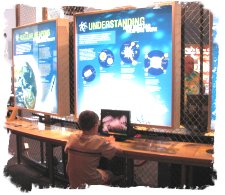 All in all, a very interesting day. Each of us found something of interest in the museum - Denise enjoyed reading the displays on WWII, I found the whole geekiness of the place irresistible, and Vance enjoyed playing around with all of the interactive displays. Los Alamos sits on top of a mesa, surrounded by deep, colorful canyons, so the drive up and back from Santa Fe was very scenic.
All in all, a very interesting day. Each of us found something of interest in the museum - Denise enjoyed reading the displays on WWII, I found the whole geekiness of the place irresistible, and Vance enjoyed playing around with all of the interactive displays. Los Alamos sits on top of a mesa, surrounded by deep, colorful canyons, so the drive up and back from Santa Fe was very scenic.
Vance: The Alamos Laboratory is where the atomic bombs were created. The Bradbury Science museum was very confusing because of all the science. Did you know people receive the most radiation from medical-X-Rays? There were some funny books about math equations.
Also there was a computer to show the experiments that the scientists performed. The names of the atomic bombs were the Fat Man and Little Boy. The Little Boy used uranium and the Fat Man used plutonium. The Little Boy was dropped on Hiroshima on August 6, 1945. Then the Fat Man was dropped on Nagasaki on August 9, 1945.
THUS, JAPAN SURRENDERED AND WWII WAS OVER!

| Previous - Red or Green? | | Home | Index | | Bandelier National Moument - Next |







<< Home